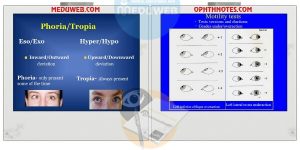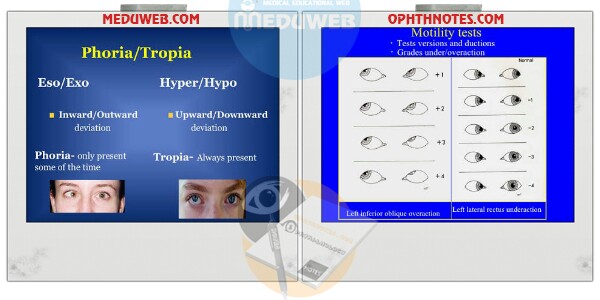Tropias and Phorias how to remember and compare simply
● You have to break up fixation by covering one eye to detect a phoria, whereas a tropia already exists but the patient is trying to fixate with both eyes ( alternating fixation on covering)
● Phorias in general are normal and whereas tropias are pathological
● Phorias are generally comitant, whereas tropias can be both comitant and noncomitant
● Phorias can be detected by the cover uncover test. When uncovering the covered eye observe for a phoria corrective refixation movement
● A tropia can be detected by the cover test. The eye that was not covered is observed for a tropia corrective fixation movement.
● Both Phoria and tropia are measured by the alternate cover test. With uncovering both eyes are observed for a correcting movement

How to do Cover Test to Detect Tropias
● The patient fixes a target with both eyes
● Cover one eye
● Watch the other eye for a tropia corrective movement
● If no movement occurs, repeat the process covering the other eye
How to do Cover/Uncover Test to Detect Phorias
● The patient fixes a target while one eye is covered
● Remove the occluder and watch for any corrective movements in the just uncovered eye repeat for the other eye to detect any corrective movements
Simpler Way of Dealing with Phorias Versus Tropias
● Do a simple cover test to detect a tropia
● Then do an alternate cover test in the various
positions of gaze
If the initial cover test did not detect a tropia, then
you have detected and measured a phoria
If the initial cover test detect a tropia, then you
have detected and measured a tropia
Other important tests
Prism cover test
1- measures the angle of deviation.
2-Repeat the alternate cover test, but with a prism bar placed in front of one eye, adjusting the prism strength until neutralization and then reversal of the corrective movement occurs.
3-The prism should be orientated infront of the eye with apex in the direction of deviation(base-out for an esotropia)
Maddox tests
1- dissociative tests in which different images are presented to each eye
2- assess symptomatic phorias: whether for distance (maddox rod), for near (maddox wing), or torsional (two maddox rods).
Maddox rod (For distance)
1- a single maddox rod (series of red cylinders) is placed horizontally in front of the right eye, and the patient (with distance correction) fixates on a distant spot of white light. 2- The patient will see a vertical red line and a white spot.
3- If there is no phoria, the line will pass straight through the spot.
4- If the image is crossed (the line is to the left of the light), there is an exophoria)
5- if the line is to the right(there is an esophoria).
6-The phoria is then quantified by the prism required to neutralize it.
7-The maddox rod is then oriented vertically and the procedure repeated to identify any vertical phoria.
8- If the line appears above the light(there is a right hyperphoria)
9- if below, there is a left hyperphoria (quantified by prisms) .
Maddox wing (For near)
1- The patient (wearing their usual reading correction)
2- looks through the apertures to view a vertical and horizontal arrow (with the right eye) and corresponding vertical and horizontal scales (with the left eye).
3-The numbers indicated by the arrows (as seen by the patient) indicates the direction and size of the near phoria.
Double Maddox rod test (For torsion)
1- a horizontally orientated maddox rod is placed in front of each eye (one red, one white).
2-The colour of the tilted line is identified by the patient.
3-The corresponding maddox rod is rotated until the patient reports that it is vertical.
4- The rotation required indicates the size of torsion.
4- The two lines will fuse if there is no residual non-torsional deviation.


